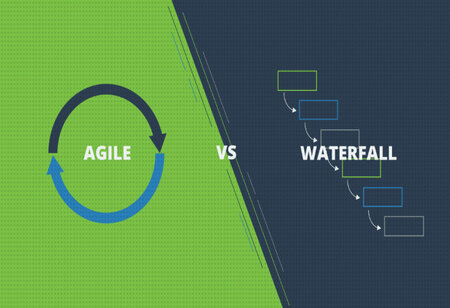Agile vs. Waterfall Project Management: Which is the Better Approach for Today's Business Environment
By Tanuja NU, Content Writer
 In today's fast-paced and ever-changing business environment, project management methodologies play a crucial role in determining the success of any venture. Two prominent approaches that have stood the test of time are Agile and Waterfall. Both have their unique strengths and weaknesses and choosing the right one can significantly impact project outcomes and overall business performance. In this article, we will explore the key differences between Agile and Waterfall project management and analyze which approach is better suited for today's dynamic business landscape.
In today's fast-paced and ever-changing business environment, project management methodologies play a crucial role in determining the success of any venture. Two prominent approaches that have stood the test of time are Agile and Waterfall. Both have their unique strengths and weaknesses and choosing the right one can significantly impact project outcomes and overall business performance. In this article, we will explore the key differences between Agile and Waterfall project management and analyze which approach is better suited for today's dynamic business landscape.
Agile Project Management:
Agile is a constant and progressive methodology that prioritizes flexibility, collaboration, and continuous improvement. It emerged as a response to the limitations of traditional Waterfall project management in handling complex and uncertain projects. In Agile, projects are broken down into smaller increases or restatements, usually referred to as sprints. Cross-functional teams work collaboratively and interact regularly with stakeholders to adapt to changing requirements and deliver working increments at the end of each sprint.
One of the primary advantages of Agile is its ability to respond quickly to changing market demands and customer feedback. This adaptability allows businesses to stay ahead of their competitors by releasing features in smaller, manageable chunks rather than waiting for the entire project to be completed. Additionally, Agile fosters a customer-centric approach, ensuring that the final product aligns more closely with user needs.
Another key strength of Agile lies in its emphasis on constant communication and collaboration within the team. Regular stand-up meetings, sprint reviews, and retrospectives promote transparency and provide valuable insights for continuous improvement.
However, Agile may not be suitable for all projects. Its success largely depends on having a skilled and motivated team that can handle frequent changes and self-organize effectively. Moreover, the lack of detailed planning at the beginning of a project can sometimes lead to scope or potential delays if not managed properly.
Waterfall Project Management:
The Waterfall model is a more traditional and linear approach to project management. It involves a sequential progression through defined phases such as requirements gathering, design, development, testing, and deployment. Each phase must be completed before moving on to the next, and changes made during later stages can be costly and time-consuming to implement.
Waterfall's structured nature makes it easier to manage and plan projects, especially those with clear and stable requirements. It provides a well-defined roadmap from the outset, making it easier to allocate resources and estimate project timelines accurately. Furthermore, Waterfall is often favoured for projects with fixed budgets and strict regulatory requirements since it is easier to track progress and maintain documentation throughout the project lifecycle.
However, the Waterfall approach may struggle to adapt to the ever-evolving business environment. Its lack of flexibility can be a hindrance when dealing with changing priorities, market conditions, or customer feedback. Additionally, stakeholders might not see a tangible product until the project's end, which can lead to potential misalignment between the final deliverable and their expectations.
Which Approach is Better for Today's Business Environment?
Deciding between Agile and Waterfall depends on various factors, including the nature of the project, the team's expertise, the level of uncertainty, and the organization's overall culture.
For projects in rapidly changing industries or with ambiguous requirements, Agile is often the preferred choice. It empowers teams to respond promptly to emerging challenges, incorporate customer feedback, and continuously refine the product. Agile's emphasis on teamwork and collaboration can also boost employee morale and creativity, leading to higher levels of engagement.
On the other hand, Waterfall may be more suitable for projects where requirements are well-defined and unlikely to change significantly. This approach can be particularly beneficial for industries with stringent regulations, where thorough documentation and predictability are crucial. In many cases, organizations adopt a hybrid approach that combines elements of both Agile and Waterfall to leverage the strengths of each methodology. This hybrid model allows businesses to be adaptive when necessary while maintaining structure and predictability for critical phases of the project.
In conclusion, there is no one-size-fits-all answer to the Agile vs. Waterfall debate in today's business environment. Each approach has its merits and limitations, and the right choice depends on the specific circumstances of the project. As businesses continue to navigate an increasingly competitive and uncertain landscape, understanding these methodologies and their applications will be key to delivering successful projects and maintaining a competitive edge.




